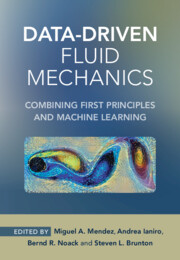
-
Select format
-
- Publisher:
- Cambridge University Press
- Publication date:
- January 2023
- February 2023
- ISBN:
- 9781108896214
- 9781108842143
- Dimensions:
- (244 x 170 mm)
- Weight & Pages:
- 1.02kg, 468 Pages
- Dimensions:
- Weight & Pages:
You may already have access via personal or institutional login
Book description
Data-driven methods have become an essential part of the methodological portfolio of fluid dynamicists, motivating students and practitioners to gather practical knowledge from a diverse range of disciplines. These fields include computer science, statistics, optimization, signal processing, pattern recognition, nonlinear dynamics, and control. Fluid mechanics is historically a big data field and offers a fertile ground for developing and applying data-driven methods, while also providing valuable shortcuts, constraints, and interpretations based on its powerful connections to basic physics. Thus, hybrid approaches that leverage both methods based on data as well as fundamental principles are the focus of active and exciting research. Originating from a one-week lecture series course by the von Karman Institute for Fluid Dynamics, this book presents an overview and a pedagogical treatment of some of the data-driven and machine learning tools that are leading research advancements in model-order reduction, system identification, flow control, and data-driven turbulence closures.
Contents
Metrics
Altmetric attention score
Full text views
Full text views help Loading metrics...
Loading metrics...
* Views captured on Cambridge Core between #date#. This data will be updated every 24 hours.
Usage data cannot currently be displayed.
Accessibility standard: Unknown
Why this information is here
This section outlines the accessibility features of this content - including support for screen readers, full keyboard navigation and high-contrast display options. This may not be relevant for you.
Accessibility Information
Accessibility compliance for the PDF of this book is currently unknown and may be updated in the future.


